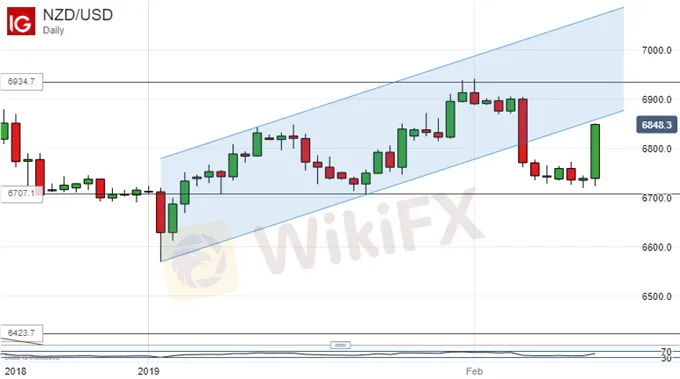简体中文
繁體中文
English
Pусский
日本語
ภาษาไทย
Tiếng Việt
Bahasa Indonesia
Español
हिन्दी
Filippiiniläinen
Français
Deutsch
Português
Türkçe
한국어
العربية
Asian Stocks Up On Trade Hopes. NZD Sharply Higher. US CPI Eyed
Abstract:Asia Pacific stocks were mostly in the green as investors hoped that something concrete will come of trade talks in Beijing between China and the
Asian Stocks Talking Points:
Most equity markets made gains Wednesday afternoo
The possibility of the US pushing back its trade deadline helped sentiment
The New Zealand Dollar made gains after its central bank left rates alone
Find out what retail foreign exchange investors make of your favorite currencys chances right now at the DailyFX Sentiment Page
Asia Pacific stocks were broadly higher Wednesday thanks to yet another revival in hopes for trade rapprochement between the US and China.
President Donald Trump Tuesday proclaimed himself open to postponing the looming March 2 deadline beyond which further tariffs will be imposed on Chinese imports if an agreement can be reached shortly.
Treasury Secretary Stephen Mnuchin and Trade Representative Robert Lighthizer are currently in Beijing for talks with Vice Premier Liu He.
The Nikkei 225 was up 1.4% as its close approached, with Shanghai up 0.9% and the Hang Seng up 0.8%. Australia‘s ASX 200 ran into some profit taking on the morning’s gains and was off by 0.4%, a solitary loser among regional mainboards.
The US Dollar weakened a little as trade hopes dulled investor appetite for perceived haven assets. The Australian and New Zealand Dollars got a lift. The latter gained sharply after its home central bank left interest rates alone. This had been widely expected but there had clearly been some suspicion in the markets that the Reserve Bank of New Zealand was going to strike an even more cautious tone on interest rates.
Governor Adrian Orr said afterwards that the chance of a rate cut had not increased in the past month.
NZD/USDs recent decline has been arrested for the moment although the pair remains below the previously dominant uptrend channel which was broken to the downside last Wednesday.

Gold prices were steady through the Asian session while crude oil prices remained elevated following Tuesdays news of more Saudi supply cuts.
The economic day‘s main remaining event will undoubtedly be the release of official US inflation figures. January’s annualized core Consumer Price Index rose is expected to have remained broadly stable at 2.1%. That data aside investors will look to a plethora of UK numbers, which include that countrys CPI. Eurozone industrial production figures are due, as is news of US mortgage-application levels.
Resources for Trader
Whether you‘re new to trading or an old hand DailyFX has plenty of resources to help you. There’s our trading sentiment indicator which shows you live how IG clients are positioned right now. We also hold educational and analytical webinars and offer trading guides, with one specifically aimed at those new to foreign exchange markets. There‘s also a Bitcoin guide. Be sure to make the most of them all. They were written by our seasoned trading experts and they’re all free.
Disclaimer:
The views in this article only represent the author's personal views, and do not constitute investment advice on this platform. This platform does not guarantee the accuracy, completeness and timeliness of the information in the article, and will not be liable for any loss caused by the use of or reliance on the information in the article.
Read more

NZD/USD Grapples 0.7000 With RBNZ’s Inflation Expectations Survey on Deck
New Zealand Dollar holds firm while risk-sensitive Australian Dollar falls overnight. RBNZ's inflation expectations survey in focus as the central bank’s rate decision nears. NZD/USD looks to retake the 0.7000 psychological level after bouncing from support

New Zealand Dollar Forecast: NZD/USD Falls as Traders Eye Chinese Inflation Data
NEW ZEALAND DOLLAR, NZD/USD, WESTPAC CONSUMER CONFIDENCE, CHINA INFLATION - TALKING POINTS

Stocks Mixed As RBA Leaves Rates Alone, Australian Data Mixed Too
Equities were mostly lower, if not by very much. Australian interest rates remained at record lows. That was as expected, but retail sales disappointed as the current account surged ahead

Stocks Slip As US Yield Curve Continues To Stoke Recession Fears
Asia Pacific equity markets failed to capitalize on Wednesdays Wall Street gains as US yield curve inversion and Brexit worries continued to dominate.
WikiFX Broker
Latest News
Exposing the Top 5 Scam Brokers of March 2025: A Closer Look by WikiFX
Gold Prices Climb Again – Have Investors Seized the Opportunity?
Webull Launches SMSF Investment Platform with Zero Fees
Australian Regulator Warns of Money Laundering and Fraud Risks in Crypto ATMs
The Withdrawal Trap: How Scam Brokers Lure Victims into Paying More
FCA to Investors: Think Twice Before Trusting These Brokers
Trump\s tariffs: How could they affect the UK and your money
Trump gambles it all on global tariffs he\s wanted for decades
HTFX Spreads Joy During Eid Charity Event in Jakarta
How Will the Market React at a Crucial Turning Point?
Currency Calculator







